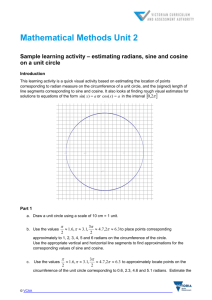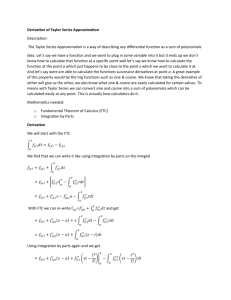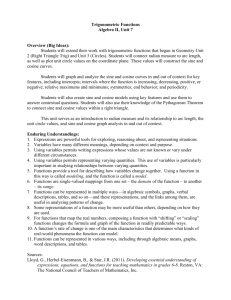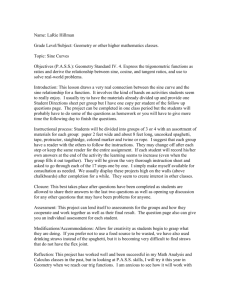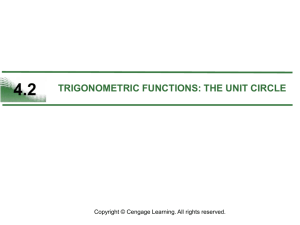ByoungKang_SpaghettiSine (1)
advertisement
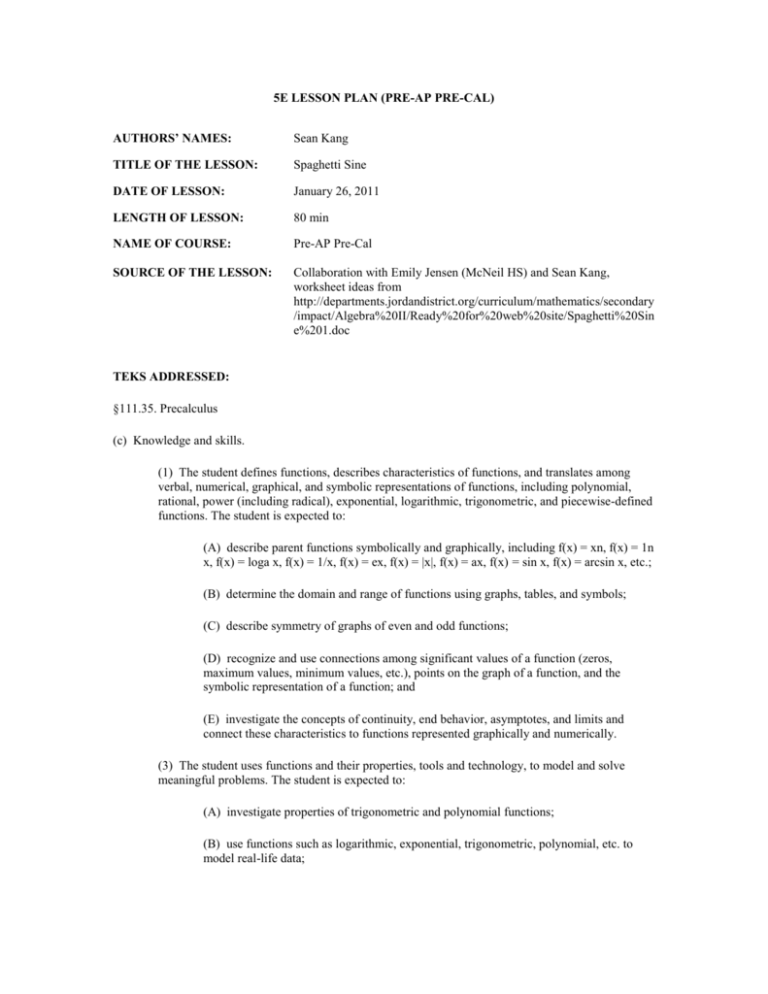
5E LESSON PLAN (PRE-AP PRE-CAL) AUTHORS’ NAMES: Sean Kang TITLE OF THE LESSON: Spaghetti Sine DATE OF LESSON: January 26, 2011 LENGTH OF LESSON: 80 min NAME OF COURSE: Pre-AP Pre-Cal SOURCE OF THE LESSON: Collaboration with Emily Jensen (McNeil HS) and Sean Kang, worksheet ideas from http://departments.jordandistrict.org/curriculum/mathematics/secondary /impact/Algebra%20II/Ready%20for%20web%20site/Spaghetti%20Sin e%201.doc TEKS ADDRESSED: §111.35. Precalculus (c) Knowledge and skills. (1) The student defines functions, describes characteristics of functions, and translates among verbal, numerical, graphical, and symbolic representations of functions, including polynomial, rational, power (including radical), exponential, logarithmic, trigonometric, and piecewise-defined functions. The student is expected to: (A) describe parent functions symbolically and graphically, including f(x) = xn, f(x) = 1n x, f(x) = loga x, f(x) = 1/x, f(x) = ex, f(x) = |x|, f(x) = ax, f(x) = sin x, f(x) = arcsin x, etc.; (B) determine the domain and range of functions using graphs, tables, and symbols; (C) describe symmetry of graphs of even and odd functions; (D) recognize and use connections among significant values of a function (zeros, maximum values, minimum values, etc.), points on the graph of a function, and the symbolic representation of a function; and (E) investigate the concepts of continuity, end behavior, asymptotes, and limits and connect these characteristics to functions represented graphically and numerically. (3) The student uses functions and their properties, tools and technology, to model and solve meaningful problems. The student is expected to: (A) investigate properties of trigonometric and polynomial functions; (B) use functions such as logarithmic, exponential, trigonometric, polynomial, etc. to model real-life data; Content Reflection: The graph of a sine or cosine function in trigonometry is directly related to the value of the function as exhibited on the unit circle. By drawing many special right triangles within the unit circle, we can determine the exact distance of any side of these triangles by using the sine/cosine/tangent relationships taught in Geometry class. The beginning of this activity solely uses the sine function, so the opposite side to the angle (centered at the origin) is the focus of all angles. As the value of the angle increases, the students will notice a periodic waving of the height of the triangle to rise up to one and decrease down to negative one, only to repeat indefinitely. This behavior is depicted visually using dried pieces of spaghetti. PERFORMANCE OBJECTIVES: Students will be able to: Graph the parent functions of sine and cosine Find the domain and range of sine and cosine functions Describe the relationship between the unit circle and both sinusoidal graphs RESOURCES, SUPPLIES, HANDOUTS: Vocabulary Worksheet (for student disability accommodation) Calculators (one per group) Spaghetti Sine Instruction Sheet (one per group) One black/dark-colored sharpie (one per group) Printout of blank unit circle (one per group) One piece of yarn long enough to cover circumference of unit circle (one per group) Scissors (one to cut yarn) Tape or glue (one per group) Large piece of butcher paper (or two blank sheets taped together) (one per group) Dried spaghetti (one package total) SAFETY CONSIDERATIONS: Preparedness for fire/severe weather drills, protective action, and emergency medical situations (Source: http://www.gccisd.net/default.aspx?name=od.links) Old spaghetti can be sharp, so don’t allow students to poke each other. It is also dirty, so do not let them eat it. DON’T RUN WITH SCISSORS! (for the teacher) ENGAGEMENT What the Teacher Will Do Discuss the behavior of a seat on a ferris wheel with students. Lead students to the periodic nature of the height, and how it constantly waves up and down. Est. Time: ___ 10 min_____ Probing Questions and Answers What the Student Will Do What shape is a ferris wheel? Answer questions and participate [Circle] in discussion What is the highest height you will go on the ferris wheel? The lowest? [Top and bottom of wheel] Have students get out unit circle Pretend the ferris wheel is our unit Look at previous notes (already completed from previous circle. What would the height be if lesson) and discuss height of sin the angle was 30 degrees? [1/2] and cos Have students get into groups of Gather materials ~3-4 and get materials for activity EXPLORATION Est. Time: __35 min___ What the Teacher Will Do Probing Questions and Answers What the Student Will Do Have groups complete “Spaghetti What pattern do you notice about Follow instructions on Spaghetti Sine” instructions the height of every special triangle? Sine sheet [It repeats up and down from -1 to 1] Monitor class to make sure What variable becomes the x-axis Cut a piece of yarn for connection is being made between on our graph? [Angle measure or circumference of circle, measure sine function and its height on unit Ѳ] height of sine at all special radian circle measures, break pieces of spaghetti to match, glue on butcher paper and create a wave function Assist students as needed putting materials together EXPLANATION Est. Time: __20 min____ What the Teacher Will Do Probing Questions and Answers Explain that each piece of spaghetti What shape does the graph of sine represents the value of sin at a make? [A wave] specific radian measure, and that there is an increasing/decreasing pattern in its value Have students graph f(x) = sin(x) in their calculator to verify their spaghetti graph is the same Have students repeat project using What function is created from horizontal distances instead of using adjacent sides instead? [cos] vertical (should create cos(x) graph) What the Student Will Do Finish spaghetti graph and present to the teacher and fellow students Graph functions on calculator Use more spaghetti and yarn for cos graph ELABORATION What the Teacher Will Do Have student groups think of a real-life situation that can be represented as a sine or cosine graph Have one student from each group share their group’s poster with the class Est. Time: ____10 min____ Probing Questions and Answers What the Student Will Do What real-life situations can you Create “poster” of their real-life think of that can be graphed using sine or cosine function a sine or cosine function? EVALUATION What the Teacher Will Do Post-assessment: Have students determine the values of sine and cosine beyond the 2π period. Have one student from each group explain why multiple answers can be the same Est. Time: ____5 min____ Probing Questions and Answers What the Student Will Do What does being periodic do to the Use spaghetti sine graph and unit values of sine and cosine beyond circle chart to answer questions 2π? Why are sin(0) and sin(2π) the Present findings to the class. same? Present group’s poster to the class. Vocabulary Worksheet (Print in Landscape) Vocabulary Definition español Trigonometry (Abbreviated trig.) The study of the measurement of triangles trigonometrÍa Unit Circle Wellreferenced circle on the Cartesian coordinate plane with a radius of 1 circulo unitario Sine Trig. function which is odd and periodic; has a range of [-1,1] and a domain of all real numbers. seno Cosine Trig. function which is even and periodic; has a range of [-1,1] and a domain of all real numbers. coseno Definitions in your own words Representation of the vocabulary (drawing, symbols, examples, etc.) Radians A unit of measurement to describe the angle between two sides radianes Spaghetti Sine Instructions , , ,... 6 4 3 1. Write the radian measure for each angle of the circle. 2. Wrap the yarn around the circle so that it is the length of the circumference of the circle. 3. Mark the angles on the yarn. 4. Straighten the yarn out and tape it to the legal size papers. 5. Label the marks on the yarn so that they correspond to the angles , , ,... 6 4 3 on the circle. 6. 6 Break one piece of spaghetti so that it is the vertical distance from the initial angle 0 to the point on 6 the circle. 7. Tape this piece above the string at the mark labeled . 6 6 4 3 2 3 8. Continue doing this for all the points on the circle. 9. Write the y value of sine at each radian measure. 4 6
